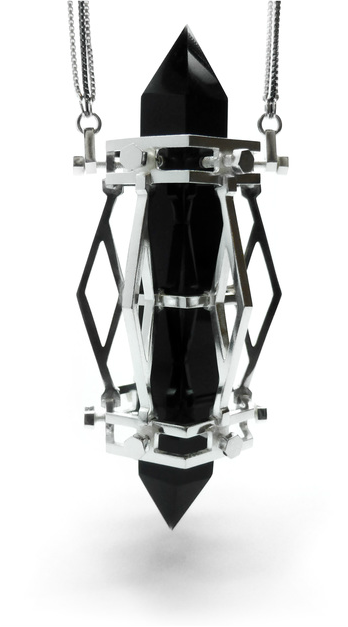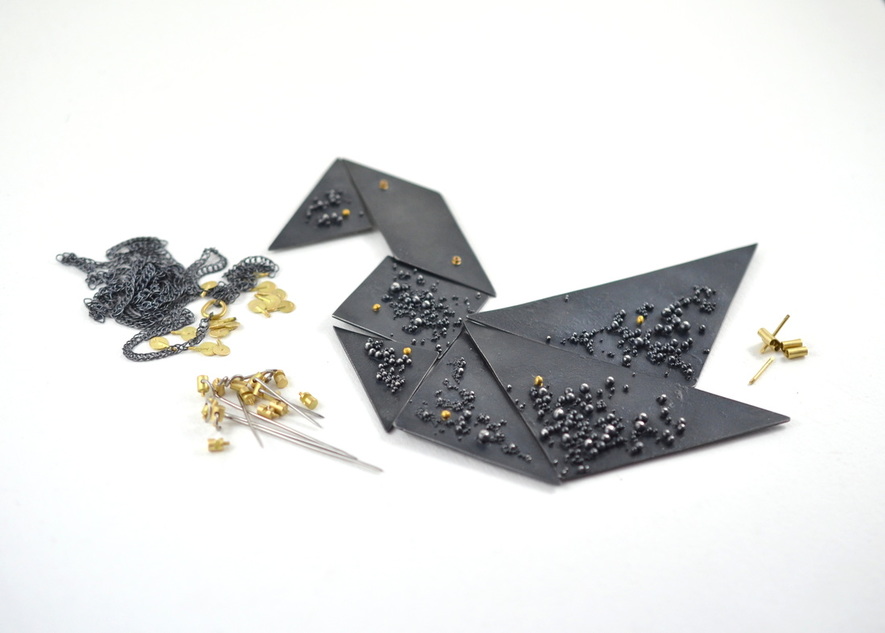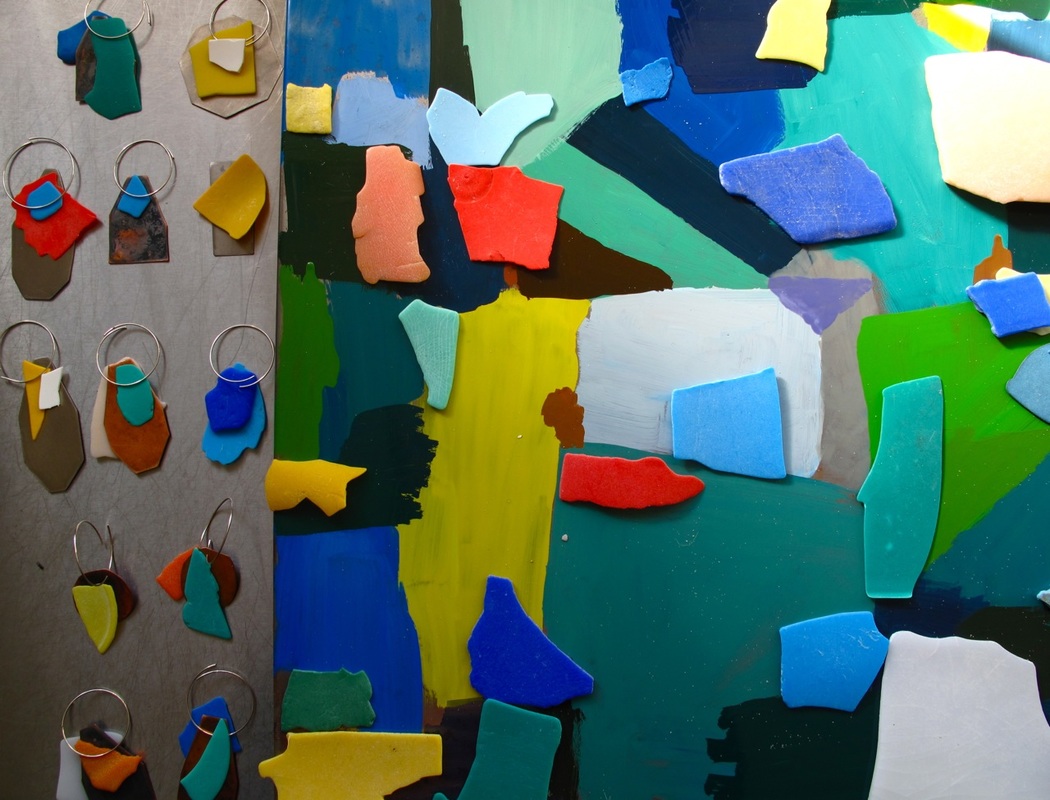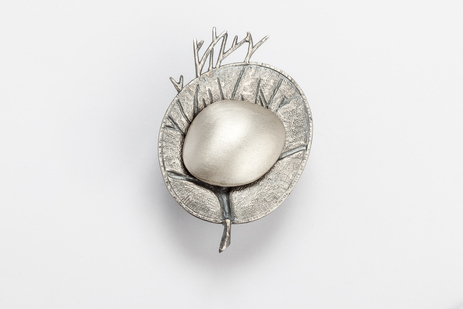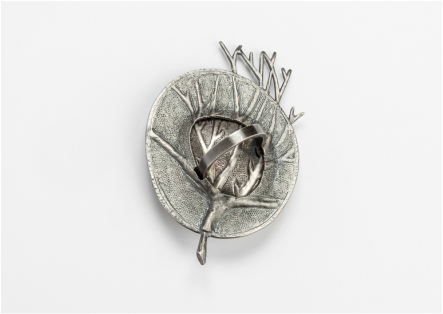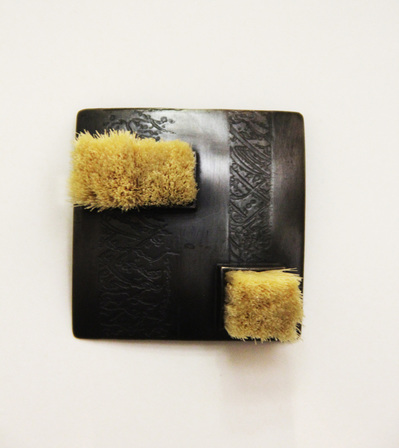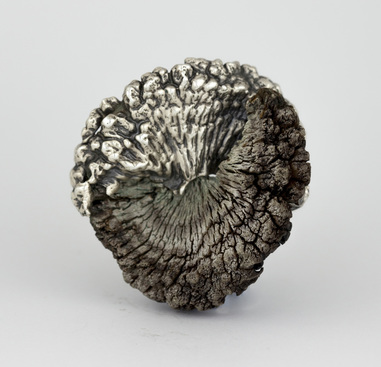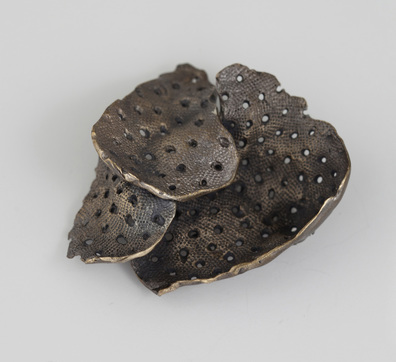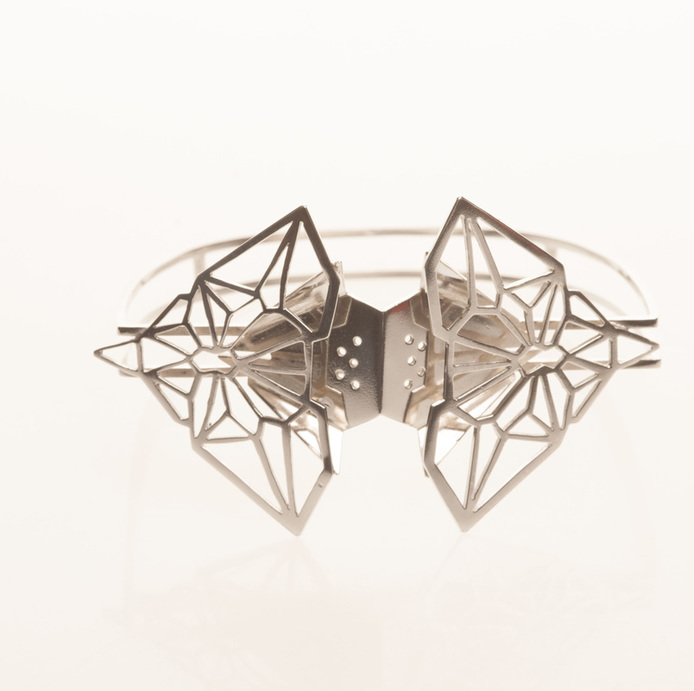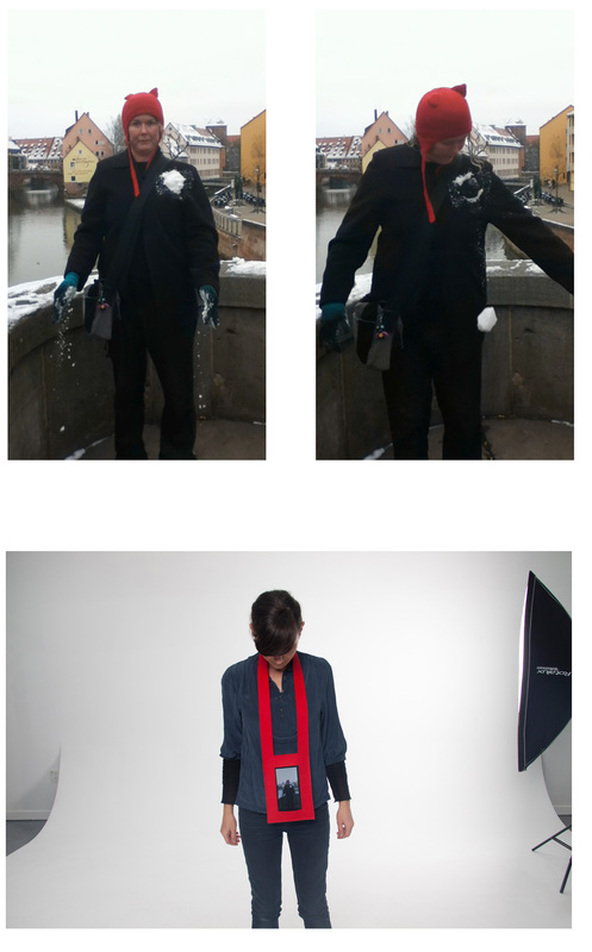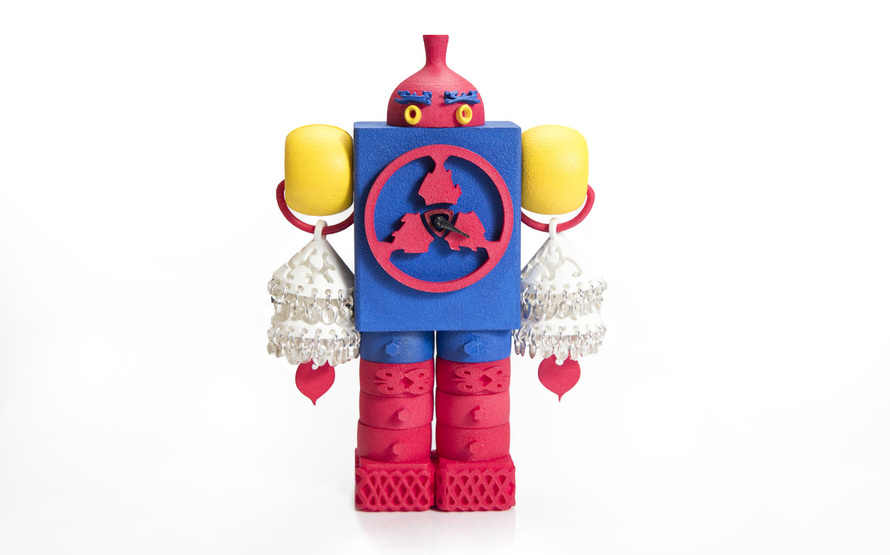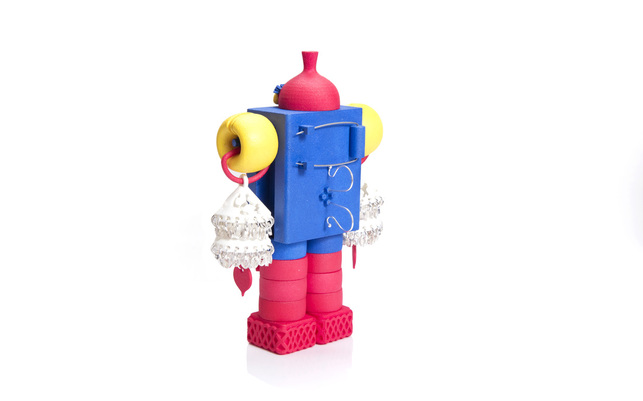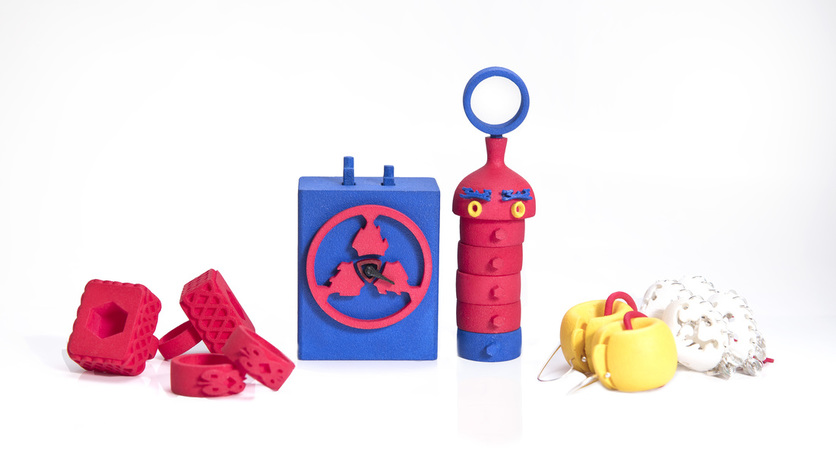Alicia Lane
Bio: Alicia Lane is a Brisbane based
cross-disciplinary artist whose work responds to relationships between
the natural and technological worlds. Her
work explores metal forms, surfaces and sound. She is currently a research candidate studying
a Doctorate of Visual Art at Griffith University.
Contact: [email protected]
Statement: I am currently studying rainforest trees of South–East Queensland and Northern New South Wales, investigating our relationships with them and how they figure in our lives to contribute to a sense of place and identity. The subject of this work is the Crows Ash, also known as the Cudgerie or Queensland Teak (Flindersia Australis), a tree that was logged extensively for its oily, honey brown timber which was often used as floorboards in older Queenslanders. It is known for its distinctive spiked woody seed cases and can be found growing in remnant forest, gardens and street plantings. The object that I have created in response to the Crows Ash reflects how the natural world is analysed, categorized and transformed into a concept within an established system of knowledge. It becomes an idea that exists apart from the life-form that it represents, much like the object that I have created exists as an interpretation of the original seedpod. The viewer is invited to touch the object to experience its tactile properties and to activate sound - samples collected from the immediate vicinity of a mature Crows Ash growing in West End, Brisbane, near where I live, reconstructed into a dreamlike series of rhythmic loops. Through this participatory, performative experience, the viewer is invited to consider how, although often unrecognized, this tree, along with many others, is enmeshed within our lives, subtly shaping perceptions of home and self.
Contact: [email protected]
Statement: I am currently studying rainforest trees of South–East Queensland and Northern New South Wales, investigating our relationships with them and how they figure in our lives to contribute to a sense of place and identity. The subject of this work is the Crows Ash, also known as the Cudgerie or Queensland Teak (Flindersia Australis), a tree that was logged extensively for its oily, honey brown timber which was often used as floorboards in older Queenslanders. It is known for its distinctive spiked woody seed cases and can be found growing in remnant forest, gardens and street plantings. The object that I have created in response to the Crows Ash reflects how the natural world is analysed, categorized and transformed into a concept within an established system of knowledge. It becomes an idea that exists apart from the life-form that it represents, much like the object that I have created exists as an interpretation of the original seedpod. The viewer is invited to touch the object to experience its tactile properties and to activate sound - samples collected from the immediate vicinity of a mature Crows Ash growing in West End, Brisbane, near where I live, reconstructed into a dreamlike series of rhythmic loops. Through this participatory, performative experience, the viewer is invited to consider how, although often unrecognized, this tree, along with many others, is enmeshed within our lives, subtly shaping perceptions of home and self.
Alister Yiap
Bio: Alister Yiap is a Western Australian artist who works in all facets within the discipline of Jewellery and 3D design. Completing a Bachelor of Art (Jewellery Design) in 2007 from Curtin University of Technology, Yiap has since won various awards and taken part in projects and initiatives nationally and internationally, including jewellery exhibitions and fashion runways. Yiap centres his work on individuality and identity, always interested in ‘self’ and how one finds themselves through art practice. With the ever growing advancement and modifications within the digital age, we too find ourselves having to adjust and change. The Micromech series looks to challenge current perspectives in design arts. New technologies and processes aid in design and is here to stay. Adapt to survive or move on out.
Website: www.alisteryiap.com.au
Statement: Fascinated by the world of facets and fashion my concept centres around identity and individuality. I’m interested in self and how one finds themselves through art practice.The attitudes I associate with are determination and endurance. As a practitioner and educator, I search for innovative ways to challenge current perspectives in design arts by utlising where possible new technologies and processes to aid in design; in the hope of inspiring new movers and makers within the contemporary jewellery industry and it keeps me on my toes. There is a level of confidence which must be coupled with the use of technology or else a whole lot of trial and error follows. The accuracy of 3D design programs are exact and paired with traditional methods of making creates a new level of work which allows me to be efficient and proficient. Micromech: Crystal Cage is the resulting work of this amalgamation that is confident and bold in both visual appearance and in contemporary language. Boasting a robust 3D form and strong construction methods, it exudes distinctive design and displays sharp tonal contrasts. With the ever growing advancement and modifications within the digital age (which almost changes every day), we find ourselves having to adjust and change. Hesitation is a common response to change, but learning to embrace and move forward with the times has its rewards. Technology is here to stay and bring on the future I say.
Website: www.alisteryiap.com.au
Statement: Fascinated by the world of facets and fashion my concept centres around identity and individuality. I’m interested in self and how one finds themselves through art practice.The attitudes I associate with are determination and endurance. As a practitioner and educator, I search for innovative ways to challenge current perspectives in design arts by utlising where possible new technologies and processes to aid in design; in the hope of inspiring new movers and makers within the contemporary jewellery industry and it keeps me on my toes. There is a level of confidence which must be coupled with the use of technology or else a whole lot of trial and error follows. The accuracy of 3D design programs are exact and paired with traditional methods of making creates a new level of work which allows me to be efficient and proficient. Micromech: Crystal Cage is the resulting work of this amalgamation that is confident and bold in both visual appearance and in contemporary language. Boasting a robust 3D form and strong construction methods, it exudes distinctive design and displays sharp tonal contrasts. With the ever growing advancement and modifications within the digital age (which almost changes every day), we find ourselves having to adjust and change. Hesitation is a common response to change, but learning to embrace and move forward with the times has its rewards. Technology is here to stay and bring on the future I say.
Anna Davern
Bio: Anna
Davern completed her undergraduate degree in Jewellery and Object Design at Sydney College of the Arts in 1993. She gained her subsequent Masters degree in Gold and Silversmithing from RMIT in 2003. In 20 years of practice, Davern has held three solo exhibitions at Craft Victoria and has been represented in numerous Australian and international solo and group exhibitions including a recent survey of Australian art at the Museum Of Contemporary Art, Taipei. In 2011 she co-founded Northcity4, an ARI that provides professional and creative opportunities to the Australian contemporary jewellery community. She has been the recipient of grants from the Australia Council, Arts Victoria and NAVA and in 2007 she undertook a residency at the Estonian Academy of Art. Davern has taught and lectured at universities and TAFEs in Australia and at the Estonian Academy of Art. Anna Davern’s practice straddles the visual arts, jewellery, fashion and education. She teaches, writes, curates and primarily makes jewellery and objects from the Northcity4 studios in Brunswick, Melbourne. Anna is a well-respected artist within the Australian contemporary jewellery and craft communities.
Website: www.annadavern.com.au
Statement: These brooches are from my recent exhibition Impressa which extended on my continuing interest in Australiana and the role the brooch has to play in describing and communicating a wearer’s cultural identity. The work for this exhibition references portrait miniatures, or Impressa from the time of Elizabeth I. During her reign these were worn by members of the court to show loyalty to the Crown and were considered useful propaganda during times of unrest and instability. Impressa also refers to symbolic devices found in the miniature paintings, which represent the bearer’s personal allegiances. Impressa were intentionally obscure as they were meant only to be understood by “those whose intellect was sufficient to fathom their meaning”. From the catalogue essay by Ramona Barry: “For Australians, the idealisation of Queen and Country divide both nation and individual as we try and tease out our belief systems. In Davern’s work the image that gets played with, split, rearranged, and complexity injected where there was simply a portrait. The changes are subtle and witty. Yes you are wearing a ‘badge’ of the Queen, but are you? Question the validity of the image and you are naturally (albeit gently) led to question the validity or utility of the figurehead.”
Website: www.annadavern.com.au
Statement: These brooches are from my recent exhibition Impressa which extended on my continuing interest in Australiana and the role the brooch has to play in describing and communicating a wearer’s cultural identity. The work for this exhibition references portrait miniatures, or Impressa from the time of Elizabeth I. During her reign these were worn by members of the court to show loyalty to the Crown and were considered useful propaganda during times of unrest and instability. Impressa also refers to symbolic devices found in the miniature paintings, which represent the bearer’s personal allegiances. Impressa were intentionally obscure as they were meant only to be understood by “those whose intellect was sufficient to fathom their meaning”. From the catalogue essay by Ramona Barry: “For Australians, the idealisation of Queen and Country divide both nation and individual as we try and tease out our belief systems. In Davern’s work the image that gets played with, split, rearranged, and complexity injected where there was simply a portrait. The changes are subtle and witty. Yes you are wearing a ‘badge’ of the Queen, but are you? Question the validity of the image and you are naturally (albeit gently) led to question the validity or utility of the figurehead.”

Anna Davern. (L-R) Sieve Slice, 2015, printed steel, mild steel. 80mm; Liz Blue Dress, 2015, re-worked tin tray, mild steel, sterling silver. 75mm; Liz Doppel, 2015, printed steel, mild steel, 65mm; Darnly Crescent Moon, 2015, printed steel, mild steel, sterling silver. 80mm; Phoenix Cresent Moon, 2015, printed steel, mild steel, sterling silver. 58mm. Image courtesy of the artist.
Anna Gray
Bio: I am an early-career jeweller, having completed my studies of jewellery in 2013. I previously studied Art History and curatorship at the University of Sydney and the University of Tasmania, and this background informs my current approach to contemporary jewellery design as the collection and arrangement of stories, ideas and forms combined with investigation of historical gold and silversmithing techniques such as granulation, repousse and plique-a-jour enamel. The themes of my pieces come from recollections of our visual world, aligning these with the sentimental and memorial nature of jewellery and the play of adornment: a painting, a sea monster, a childhood toy or a specific texture or action that evokes a memory. I am captivated by the transformation of metal from sheet to form, and I try to explore the possibilities for creating plays of light, texture, colour or shade in my work.
Website: annagrayjewellery.com
Statement: I see my process of creation as part-curatorial, collecting memory, tactility, play and imagination and using a technical and material practice to give these ideas form. The Tangrams set is an adornment concept based on play. The reference to a toy is a tactile memory from my childhood, while the use of precious materials with engineering and goldsmithing techniques, such as granulation, connect my current investigations with the memory and history of a jewellery making tradition, which I access and explore through play. Adornment allows the wearer to play with costume and expression through arrangement. My process of invention as a jeweller is inspired by the puzzleplay of drawing or arrangement of pieces on my bench, searching for an appealing shape or form, followed by decorative choices and technical considerations of how to construct/display/wear the piece. Tangrams, as a multi-modal, multi-functional set, encourages the jewellery-wearer to connect with my jeweller’s process by carrying out their own arrangement of forms and choice of display: The piece can be worn as a collective whole, articulated into any of an innumerable variety of forms and narratives, or divided abstractly around the body as individual pieces: earring, pendant or brooch. Once a display is chosen, the pieces must be ‘constructed’ with the appropriate back fittings in order to secure them. In this way both jeweller and jewellery-wearer design play through imaginative arrangement, construction and deconstruction of parts.
Website: annagrayjewellery.com
Statement: I see my process of creation as part-curatorial, collecting memory, tactility, play and imagination and using a technical and material practice to give these ideas form. The Tangrams set is an adornment concept based on play. The reference to a toy is a tactile memory from my childhood, while the use of precious materials with engineering and goldsmithing techniques, such as granulation, connect my current investigations with the memory and history of a jewellery making tradition, which I access and explore through play. Adornment allows the wearer to play with costume and expression through arrangement. My process of invention as a jeweller is inspired by the puzzleplay of drawing or arrangement of pieces on my bench, searching for an appealing shape or form, followed by decorative choices and technical considerations of how to construct/display/wear the piece. Tangrams, as a multi-modal, multi-functional set, encourages the jewellery-wearer to connect with my jeweller’s process by carrying out their own arrangement of forms and choice of display: The piece can be worn as a collective whole, articulated into any of an innumerable variety of forms and narratives, or divided abstractly around the body as individual pieces: earring, pendant or brooch. Once a display is chosen, the pieces must be ‘constructed’ with the appropriate back fittings in order to secure them. In this way both jeweller and jewellery-wearer design play through imaginative arrangement, construction and deconstruction of parts.
Ari Athans
Bio: Contemporary jeweller Ari Athans opened her gallery workshop in 2004 after twelve years of exhibiting and selling her jewellery nationally and internationally. Ari Jewellery is located in the heart of New Farm on bustling Brunswick Street, Brisbane, Australia. The long, narrow white space displays an evolving range of limited edition neckpieces, earrings and rings.Ari exhibits three new seductive jewellery ranges a year and welcomes the opportunity to work collaboratively on commissions. The gallery space also exhibits established and emerging ceramic artists. Ari works primarily with stone and precious metal with a strong preference for unusual gemstone cuts and raw geologic samples such as basalt, rough diamonds, emerald crystals, natural coral, quartz crystals, serpentine, hematite, black tourmaline and pearls. She sources her stones from around the world and locally through gem fairs and likens this process to fossicking. Her minimalist approach to design enhances the raw geologic samples and gemstones in each piece and reflects randomness and order in crystal growth. Ari studied geology at the University of Technology, Sydney and worked in the mining and exploration industry. She then went on to study jewellery and object design at Randwick TAFE, Sydney and never looked back. Geology to jewellery was a very natural progression and is almost always the starting point for all projects outside of jewellery. Since her move from Sydney to Brisbane 18 years ago Ari has built up a strong local and international following of her work. Ari’s jewellery has appeared in solo and major group shows in Brisbane, Sydney, Melbourne, Edinburgh, London, Munich, Singapore and Tokyo and most notably ‘Australian Freestyle’ at Triennale Museum in Milan. Her work is held in public and private collections. Ari also exhibits her paintings at Edwina Corlette Gallery.
Website: Ari Jewellery
Statement: My approach to making jewellery is always influenced by other projects I may be working on at the time and is always process driven. I was working on my painting show and naturally wanted to experiment with paint on jewellery. I got as far as cutting the metal shapes and then we went to Stradbroke Island for a few days. In our final hours we went to South Gorge beach and I was shocked and awed by the sheer amount of pumice and plastic that had filled the gorge beach. I immediately connected the plastic shapes and colours to my brushwork. I madly started collecting. It was quite a contrast – the pumice with the plastic. Different origins, however the two materials travelled the oceans together and were deposited on this beach simply because they share the same density.
Website: Ari Jewellery
Statement: My approach to making jewellery is always influenced by other projects I may be working on at the time and is always process driven. I was working on my painting show and naturally wanted to experiment with paint on jewellery. I got as far as cutting the metal shapes and then we went to Stradbroke Island for a few days. In our final hours we went to South Gorge beach and I was shocked and awed by the sheer amount of pumice and plastic that had filled the gorge beach. I immediately connected the plastic shapes and colours to my brushwork. I madly started collecting. It was quite a contrast – the pumice with the plastic. Different origins, however the two materials travelled the oceans together and were deposited on this beach simply because they share the same density.
Bianca Mavrick
Bio: Bianca Mavrick is a contemporary jeweller and object maker who works across diverse palette of precious and everyday materials. She handcrafts bold, unique and colourful oversized earrings and one-off necklaces and bracelets. Inspired by the anti-design movement of the 1980s, Bianca is fascinated by urban sub-cultural tribes and the experience of Australian life. She handcrafts bold, unique and colourful oversized earrings and one-off necklaces and bracelets. Inspired by the anti-design movement of the 1980s. Bianca has trained as a gold and silversmith, completing a Bachelor of Fine Art, Jewellery and Small Objects at the Queensland College of Art, Griffith University in 2013. She was born in Brisbane in 1989.
Website: Bianca Mavrick
Statement: I am interested in collaboration and relational craft. This aspect of my practice developed after reading the essay ‘Relational craft and Australian fashionability in the 1970’s-80s: Friends, pathways, ideas and aesthetics’ by Sally Gray(1). I was moved by my own romantic imaginings of time and practices of the key players Peter Tully, David McDiarmid, Linda Jackson, Jenny Kee and Clarence Chai. Not only by the aesthetics they explored, but by their collaborative relationships and friendships. This motivated me to endeavour to collaborate with my friends from other disciplines, which creates interesting intersections between contemporary jewellery, fashion and design culture. This image exhibited is a result of a collaboration between a group of my friends, where we imagined a girl who personified the jewellery pieces. Her personal attitude is to be a ‘maximalist’, which she expresses through body adornment. Fashion photographer Jonathan Rae, Journalist Saskia Edwards and myself used google maps to find mundane suburban locations to contrast with the excessive dress. We collaborated to borrow clothing from our own wardrobes to dress the model, or friend Eloise Breskvar.
(1) Sally Gray, 2012, Relational Craft and Australian Fashionability in the 1970’s-80s: Friends, Pathways, Ideas and Aesthetics. In Craft + Design Inquiry; issue 4, Editors Peter McNeil, Rosemary Hawker, ANU E Press http://bit.ly/1ISeNUe
Website: Bianca Mavrick
Statement: I am interested in collaboration and relational craft. This aspect of my practice developed after reading the essay ‘Relational craft and Australian fashionability in the 1970’s-80s: Friends, pathways, ideas and aesthetics’ by Sally Gray(1). I was moved by my own romantic imaginings of time and practices of the key players Peter Tully, David McDiarmid, Linda Jackson, Jenny Kee and Clarence Chai. Not only by the aesthetics they explored, but by their collaborative relationships and friendships. This motivated me to endeavour to collaborate with my friends from other disciplines, which creates interesting intersections between contemporary jewellery, fashion and design culture. This image exhibited is a result of a collaboration between a group of my friends, where we imagined a girl who personified the jewellery pieces. Her personal attitude is to be a ‘maximalist’, which she expresses through body adornment. Fashion photographer Jonathan Rae, Journalist Saskia Edwards and myself used google maps to find mundane suburban locations to contrast with the excessive dress. We collaborated to borrow clothing from our own wardrobes to dress the model, or friend Eloise Breskvar.
(1) Sally Gray, 2012, Relational Craft and Australian Fashionability in the 1970’s-80s: Friends, Pathways, Ideas and Aesthetics. In Craft + Design Inquiry; issue 4, Editors Peter McNeil, Rosemary Hawker, ANU E Press http://bit.ly/1ISeNUe
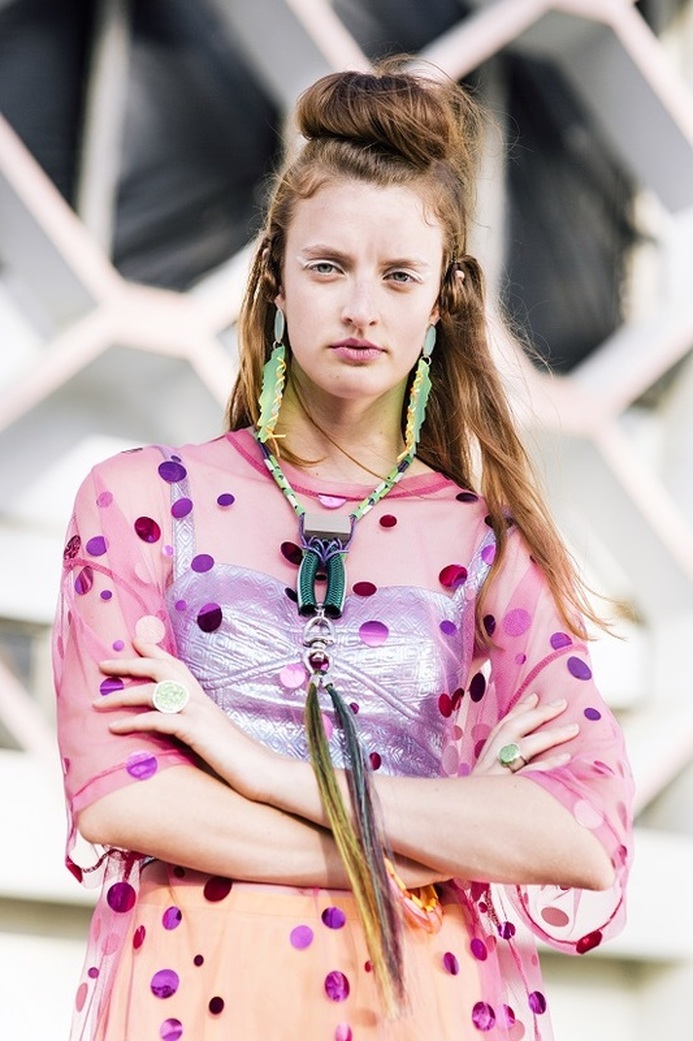
Bianca Mavrick, untitled, 2014, digital photograph, (Aloe Vera Earrings, 2013, sterling silver, cold enamel, resin, plastic; Garden Harness Necklace, 2014, elastic, dyed horsehair, garden hose, metal hook, plastic, timber, powder coated brass; Disc Rings, 2013,
sterling silver, cold enamel, glitter. Modelled by Eloise Breskvar. Photograph by Jonathan Rae.
Blandine Hallé
Bio: The exploration of her sense of identity and belonging through her emotional and cultural experiences is the focus of Blandine’s artwork. For this she uses a variety of media from jewellery and assemblage of found objects, to photography, photo imaging, drawing and writing. Blandine was born in Paris where she lived until she was 26. Personal and family traumas led her to a nomadic lifestyle for many years. Her travels brought her to Western Australia where she has been living since 1997. Drawing on her eclectic background, she plays with the relationships of lines, colours, shapes and textures. She uses photography, drawing, CAD and modelling to explore her designs and how to translate them into three dimensional objects. Blandine loves to experiment processes and techniques, such as a non-toxic etching process that she has now mastered (no acid used as opposed to traditional etching). In 2013, she graduated from the Advanced Diploma in Jewellery Design at Central Institute of Technology, Perth (WA) and received the ‘Australia Award for Academic & Design Excellence in the Art of Jewellery’. During the course of her studies, she also received the ‘Outstanding Student Work’ award at the Wearable Narrative exhibition (JMGA WA, 2012). Since then, her work has been shown in several exhibitions in Perth and Brisbane. In 2014, she received the ‘Addressed the theme most successfully’ award at the Wear/Ware/Where exhibition (JMGA WA, 2014). Also in 2014, Blandine was selected for a touring group exhibition, Marken-Schmuck, in Germany at Studio Green (Munich) and at Galerie Blickfang (Weilheim).
Website: Blandine Hallé
Statement: The numbers embossed on the silver rectangles are a symbol of past events, like an imprint of memory. I used the images of numbers stamped on the Munich U-Bahn tickets when you validate them. They record where you have been, what day, what time. This reflects my own looking back at the story of my life as I am currently facing personal challenges and I am uncertain about the future. The straight lines of the rectangles act as a reassuring frame in my unsecure state of mind. In my head I am hanging on to some idea of perfection, which doesn’t exist in reality. I stitched the rectangles together with red thread: I am sawing up the cloth of my life, shredded, torn in pieces, trying to make sense of it. With those stitches, I am joining the edges of my wounds, so they can heal. The red thread is the blood running through my veins, keeping me alive and moving forward. Buttons tighten things together, join them. My mother gave me these antique buttons years ago. They represent the sweetness of childhood, that sense of security that you feel knowing your mother loves you. Through their roundness and softness, they bring balance to the rectangles in the necklace. In the same balancing way that knowing someone cares for me has a soothing effect and helps me overcome my difficulties.
Website: Blandine Hallé
Statement: The numbers embossed on the silver rectangles are a symbol of past events, like an imprint of memory. I used the images of numbers stamped on the Munich U-Bahn tickets when you validate them. They record where you have been, what day, what time. This reflects my own looking back at the story of my life as I am currently facing personal challenges and I am uncertain about the future. The straight lines of the rectangles act as a reassuring frame in my unsecure state of mind. In my head I am hanging on to some idea of perfection, which doesn’t exist in reality. I stitched the rectangles together with red thread: I am sawing up the cloth of my life, shredded, torn in pieces, trying to make sense of it. With those stitches, I am joining the edges of my wounds, so they can heal. The red thread is the blood running through my veins, keeping me alive and moving forward. Buttons tighten things together, join them. My mother gave me these antique buttons years ago. They represent the sweetness of childhood, that sense of security that you feel knowing your mother loves you. Through their roundness and softness, they bring balance to the rectangles in the necklace. In the same balancing way that knowing someone cares for me has a soothing effect and helps me overcome my difficulties.
Christine O'Reilly
Bio: Christine O'Reilly is a Sunshine Coast based artist who works primarily in base and precious metals.She graduated from University of Queensland in 1989 with a Bachelor of Occupational Therapy and went on the specialize in the areas of Oncology and Acute Psychiatry. Working with the often terminally ill and those experiencing difficulties coping with life issues and stresses laid the ground work for an art practice which explores the intrinsic and extrinsic dynamics of human personality and the interplay between internal and external communication. Initially working in the areas of drawing and painting, working with metal came when she commenced a Bachelor of Fine Art at Queensland College of Art in Brisbane in 2004, and for her it was "like coming home...". The processes and materials were akin to her rural upbringing and a very natural extension of her prior profession. She has exhibited regionally, nationally, and internationally, produces work for retail, and presently produces commission based work from her home studio.
Contact: [email protected]
Statement: The duality of being and the intricate nature of the process of personal change is inherent in my constant exploration of form, material, and process with an emphasis on surface manipulation and mark making. The process of making is both the physical and psychological vehicle which allows the expression of observations and contemplations and is strongly influenced by the natural environment, and personal observations of the complexity of relationships directly around me. I work with the understanding that a positive sense of wellbeing correlates directly to an involvement in productive work and the process of being creative. Jewellery constitutes a complex statement of social fact and personal fantasy which other people in the same culture recognize and interpret. Personal ornamentation exerts a subtle control of the coded messages the wearer imparts and is embedded with the personal messages of the maker , a vehicle for connection between the outward image and the inner image thus assisting in the establishment and enhancement of identity. On the body jewellery has a subtext, a marker or cipher in sign language. It has the ability to communicate to a large audience, to speak of human connectedness and in particular the intimate connection between artist and the public. By the very nature of its form, jewellery touches people. It facilitates human contact. These works consider the role of the maker and wearers of jewellery. The inherent benefits of the rituals of life, the act of giving and receiving, and the power of touch, which allows one to replenish and renew everyday patterns of thinking.The rings carry the words "from me" and "to you" in braille in 9ct yellow gold on the inner surface.
Contact: [email protected]
Statement: The duality of being and the intricate nature of the process of personal change is inherent in my constant exploration of form, material, and process with an emphasis on surface manipulation and mark making. The process of making is both the physical and psychological vehicle which allows the expression of observations and contemplations and is strongly influenced by the natural environment, and personal observations of the complexity of relationships directly around me. I work with the understanding that a positive sense of wellbeing correlates directly to an involvement in productive work and the process of being creative. Jewellery constitutes a complex statement of social fact and personal fantasy which other people in the same culture recognize and interpret. Personal ornamentation exerts a subtle control of the coded messages the wearer imparts and is embedded with the personal messages of the maker , a vehicle for connection between the outward image and the inner image thus assisting in the establishment and enhancement of identity. On the body jewellery has a subtext, a marker or cipher in sign language. It has the ability to communicate to a large audience, to speak of human connectedness and in particular the intimate connection between artist and the public. By the very nature of its form, jewellery touches people. It facilitates human contact. These works consider the role of the maker and wearers of jewellery. The inherent benefits of the rituals of life, the act of giving and receiving, and the power of touch, which allows one to replenish and renew everyday patterns of thinking.The rings carry the words "from me" and "to you" in braille in 9ct yellow gold on the inner surface.
Claire McArdle
Bio: Claire McArdle is an Australian contemporary jeweller living and practicing in Melbourne. With a BA in Gold & Silversmithing (1st Class Honours) from the RMIT University, McArdle is an active member of the contemporary jewellery community as both maker and curator. McArdle has engaged in a number of contemporary jewellery projects including, as curator of the internationally touring exhibition, Words and Works from a World Away and as the co-Director of Radiant Pavilion: Melbourne. Her work has received international recognition with work exhibited in Thailand, Hong Kong, USA, United Kingdom, Germany, France, Austria and The Netherlands. McArdle has undertaken residencies in Australia, Mexico, Iceland and Estonia and was awarded first prize at Contemporary Wearables ’13. Excerpt from klimt02
Website: Claire McArdle
Statement: Power explores how information can influence the viewing of a work. How words can shift the immediate feelings experienced upon an encounter with a piece. It seeks to question the values we place on feeling and thinking and bring focus to the experience of a piece as an evolution of feeling, shaped and reshaped by thinking.
Website: Claire McArdle
Statement: Power explores how information can influence the viewing of a work. How words can shift the immediate feelings experienced upon an encounter with a piece. It seeks to question the values we place on feeling and thinking and bring focus to the experience of a piece as an evolution of feeling, shaped and reshaped by thinking.
Claire Townsend
Bio: Claire Townsend is a contemporary jeweller based in Perth, WA. Claire completed her Master of Art at Curtin University in 2001, and has continued to study both locally and internationally. Claire has been teaching within tertiary institutions since completing her Masters, and in 2012 opened Perth's first privately run jewellery school, Contemporary Metal. She continues to make and exhibit, while teaching and growing the school. Claire has exhibited extensively and has been the recipient of grants, the most recent being a mid career fellowship in 2011 from the department of Culture and Arts, WA.
Website: Contemporary Metal
Statement: I am interested in relationships, and the marks and impressions we leave on each other through our interactions. My work focuses on the use of materials that make marks and complement and enhance each other, a lot like we do within our relationships. My rings are mostly 2 parts, companion rings, and I use the two separate pieces to represent and comment on people, and how they interact. The rings are symbols of beauty and love, with an underlying message about our closer impacts and marks we leave on one another.
Website: Contemporary Metal
Statement: I am interested in relationships, and the marks and impressions we leave on each other through our interactions. My work focuses on the use of materials that make marks and complement and enhance each other, a lot like we do within our relationships. My rings are mostly 2 parts, companion rings, and I use the two separate pieces to represent and comment on people, and how they interact. The rings are symbols of beauty and love, with an underlying message about our closer impacts and marks we leave on one another.
- Claire Townsend, Marked, 2015, Sterling and Fine Silver, 40Lx30Wx20Dmm. Image by Bewley Shaylor.
Fatemeh Boroujeni
Bio: Fatemeh Boroujeni, b. 1981 in Shahrekord, Iran, is a contemporary artist and designer currently based in Australia. Originally trained as a painter at Tehran University and industrial design at Azad University (Bachelor of Industrial Design), Boroujeni later pursued graduate studies in the applied arts at Curtin University (Master of Applied Design and Arts). Most recently she pursued an Advanced Diploma of Jewellery Design at the Central institute of Technology in Australia, exploring the realm of fine jewellery and wearable art. Boroujeni’s work often combines references to Persian design with clean, elegant forms sometimes reminiscent of the modern minimalism of Japanese craftsmanship. Boroujeni’s cross-cultural background creates a contemporary dialogue in her work that draws from global influences and combines points of view in surprising ways.
Contact: [email protected]
Statement: The paint brush is one of basic tools of the artist, allowing a multitude of results from the most simple of materials. The softness of hair contrasts with hardness of wood or plastic. Variations in the shape create particular textures or effects with paint. Hair is one of the most important elements of a brush, from quality and setting to type of fiber. Each artist knows their brushes intimately, employing the unique qualities and personality of each individual brush. I am inspired by the humble brush, this tool with infinite potential, which can be used to create sensational masterpieces of incredible value. In my work, the hair of the brush also references its importance in Persian art, painting and calligraphy. I combine elements of tradition in surprising, contemporary designs and forms. In this work, I have deconstructed the form of the brush to its most basic elements. By removing the components of the brush from the sphere of utility and elevating them to art, I explore the meaning and possibilities inherent in these tools of the artist’s work. With a minimal, elegant form, this piece evokes the vast possibilities contained in the simple artist’s brush. I also use the brush as a personal signature, representing the dual nature of my personality and skills. Softness and hardness, dark and light, dull and shiny surfaces; each aspect creates significant contrast and symbolizes the different sides of our inner and outer selves.
Contact: [email protected]
Statement: The paint brush is one of basic tools of the artist, allowing a multitude of results from the most simple of materials. The softness of hair contrasts with hardness of wood or plastic. Variations in the shape create particular textures or effects with paint. Hair is one of the most important elements of a brush, from quality and setting to type of fiber. Each artist knows their brushes intimately, employing the unique qualities and personality of each individual brush. I am inspired by the humble brush, this tool with infinite potential, which can be used to create sensational masterpieces of incredible value. In my work, the hair of the brush also references its importance in Persian art, painting and calligraphy. I combine elements of tradition in surprising, contemporary designs and forms. In this work, I have deconstructed the form of the brush to its most basic elements. By removing the components of the brush from the sphere of utility and elevating them to art, I explore the meaning and possibilities inherent in these tools of the artist’s work. With a minimal, elegant form, this piece evokes the vast possibilities contained in the simple artist’s brush. I also use the brush as a personal signature, representing the dual nature of my personality and skills. Softness and hardness, dark and light, dull and shiny surfaces; each aspect creates significant contrast and symbolizes the different sides of our inner and outer selves.
Fatemeh Boroujeni, What I am: from The Humble Brush Contains Multitude series, 2014,
Oxidized copper, brush bristles, stainless steel, 53Wx53Hx17Dmm. Image courtesy of the artist.
Oxidized copper, brush bristles, stainless steel, 53Wx53Hx17Dmm. Image courtesy of the artist.
Laura Burstow
Bio: Studying a Bachelor of Fine Art at the Queensland College of Arts. Exhibited work at the Contemporary Artisans Collective – Spectacle exhibition and the Queensland College of Arts Graduate Showcase exhibition. I create and sell jewellery at local artisan markets including Brisbane Artisan Markets, Mini Design Markets and Young Designers Markets.
Website: Laura Burstow
Statement: My work deals directly with the production of sound. My attitude is to create works and wearables that are not static. I create works that use mechanics and wearer interaction that have a lasting effect on the wearer. My attitude takes advantage of the strong link between sound and emotion. The mind creates strong associations between sound and specific stimulus. Sound can make a person vividly recall certain places, events or people. This special quality of sound brings life and colour to colourless objects.
Hear Laura Burstow's Ring.
Website: Laura Burstow
Statement: My work deals directly with the production of sound. My attitude is to create works and wearables that are not static. I create works that use mechanics and wearer interaction that have a lasting effect on the wearer. My attitude takes advantage of the strong link between sound and emotion. The mind creates strong associations between sound and specific stimulus. Sound can make a person vividly recall certain places, events or people. This special quality of sound brings life and colour to colourless objects.
Hear Laura Burstow's Ring.
Lisa Walker
Bio: Lisa Walker is an artist/jeweller/designer mostly working in the area of contemporary jewellery. She exhibits and is involved in projects with museums, galleries, and other venues around the world. She is regularly invited to teach workshops and give lectures. After many years spent living in Munich, Germany, Walker is currently based in her city of birth Wellington, New Zealand
Website: Lisa Walker
Statement: I research the differences between an acceptable notion of beauty or stereo-type, and something else – the search for an aesthetic that we hardly ever see, but nevertheless perhaps recognise. I don't want to make pieces that are easily steered through our established channels, I want people to be forced to work on new syllogisms, analogies and positions. I push towards the extreme, and see this is a method which enables an expansion in thinking and ways of working. I use a large range of materials and techniques. I make reactionary work, consciously active with influences from all walks of culture and life. The pieces are often laced with references to contemporary jewellery of the last forty years, questioning and researching what jewellery means, what it can be, though recognising too that ignoring the big jewellery questions at times is just as important. I position my work around the history, future, and boundaries of jewellery. I make pieces for the future. Everything is food for art.
Website: Lisa Walker
Statement: I research the differences between an acceptable notion of beauty or stereo-type, and something else – the search for an aesthetic that we hardly ever see, but nevertheless perhaps recognise. I don't want to make pieces that are easily steered through our established channels, I want people to be forced to work on new syllogisms, analogies and positions. I push towards the extreme, and see this is a method which enables an expansion in thinking and ways of working. I use a large range of materials and techniques. I make reactionary work, consciously active with influences from all walks of culture and life. The pieces are often laced with references to contemporary jewellery of the last forty years, questioning and researching what jewellery means, what it can be, though recognising too that ignoring the big jewellery questions at times is just as important. I position my work around the history, future, and boundaries of jewellery. I make pieces for the future. Everything is food for art.
Marisa Molin
Bio: Whether my works are large-scale public sculptures or intimate wearables, they all derive their form from nature that is specific to Tasmania. I translate textures of fragments, collected from walks along shorelines and from Tasmania’s vast wilderness to become intricate artworks. The symbiotic relationship between the fragment and its environment is mirrored in my work via the relationship between jewellery and its wearer. My designs become a part of the wearer, each piece of jewellery intimately following the curves of the wearer's body, and at once, sprouting from the body and assuming its own form. In itself, this is a deliberate act; embodying the logic of the ecosystem, whilst reflecting on our relationship as humans, to the wilderness. Since returning to Tasmania from 4 years abroad in Greece, shorelines and in particular remote island shorelines have become the current focus of my practice. My experiences have taught me that each island has a unique personality which can only form from their isolation and remoteness. Flinders Island and King Island are the first two chapters of my current series entitled, fragments of...
Website: Marisa Molin
Statement: I map the coastline of islands by collecting textures and fragments found from the shoreline. I take these fragments and their secret narratives into my studio and translate them into wearable objects. By doing so, I aim to create a collective and visual dialogue about an island, as each island is unique. These works are from the Fragments of Kingseries, which is an outcome of an Artist Residency on King Island (2015). The symbiotic relationship I observe between the fragment and its environment is mirrored in my work via the relationship between jewellery and its wearer. My designs become a part of the wearer, each piece of jewellery intimately following the curves of the wearer's body, and at once, sprouting from the body and assuming its own form. In itself, this is a deliberate act; embodying the logic of the ecosystem, whilst reflecting on our relationship as humans, to the wilderness.
Website: Marisa Molin
Statement: I map the coastline of islands by collecting textures and fragments found from the shoreline. I take these fragments and their secret narratives into my studio and translate them into wearable objects. By doing so, I aim to create a collective and visual dialogue about an island, as each island is unique. These works are from the Fragments of Kingseries, which is an outcome of an Artist Residency on King Island (2015). The symbiotic relationship I observe between the fragment and its environment is mirrored in my work via the relationship between jewellery and its wearer. My designs become a part of the wearer, each piece of jewellery intimately following the curves of the wearer's body, and at once, sprouting from the body and assuming its own form. In itself, this is a deliberate act; embodying the logic of the ecosystem, whilst reflecting on our relationship as humans, to the wilderness.
Marisa Molin 2015 – clockwise - Kelp Track Wandering,
sterling silver, kelp, stainless steel (brooch); Naracoopa Wandering, sterling
silver, keum boo and stainless steel (Brooch).
Colony Of Zooids residing, bronze, sterling silver and stainless steel
(brooch); Nautilus, sterling silver, (ring) All works part of the Fragments of
King series. Photographs by Mel De Ruyter
Michelle Wadsworth
Bio:Michelle was born in Melbourne Victoria from an ancestry line in Architecture and Gold Mining. Her parents passed on the creative gene, both makers; her Father a Metalurgist and Master Wood Craftsmen. Her creative talents emerged through her teenage years growing up in Perth WA. She expressed herself through art, sewing and decorating and went on to lead a successful career in Makeup Artistry and Fashion Merchandising. After studying Visual Arts she chose to select her medium in metal thus directing her towards Jewellery Design and offering a link back to her interest in body adornment. Michelle is currently pursuing an Advanced Diploma in Jewellery Design and works on renovating and illustrating projects at home.
Contact: Michelle Noble Design
Statement: SHARK CULLING AT PERTHS BEACHES is happening right now. This government run program sees baited hooks and lines placed metres off our swimming beaches in a bid to reduce shark attack victims. This season two swimmers have been attacked and within a season hundreds of sharks have been baited, drowned and killed, several being over the 3 metre size. The big ones are our breeders. The hooks are not being selective, all of these magnificent creatures are being killed with no supposed threat to the species. A need has arisen to better understand breeding patterns, feeding and territories. My attraction to the shark like most of us comes from fear. There is little we know about them, the focus is always on their killing power. I see a creature of great power and magnificence. The shark’s form is sleek and swift as they quietly glide through our oceans. Terrifying? Or beauty in an extremely clever design? Speed and agility, a unique skin and arrow formed scales allow for ultimate water propelling. Through research and development, I based my element of design on the shark skin pattern. It took me to a geometric aesthetic which I further developed into a bracelet design. I wanted the element to show through as a main feature on my piece to represent this sleek fearless Apex Predator.
Contact: Michelle Noble Design
Statement: SHARK CULLING AT PERTHS BEACHES is happening right now. This government run program sees baited hooks and lines placed metres off our swimming beaches in a bid to reduce shark attack victims. This season two swimmers have been attacked and within a season hundreds of sharks have been baited, drowned and killed, several being over the 3 metre size. The big ones are our breeders. The hooks are not being selective, all of these magnificent creatures are being killed with no supposed threat to the species. A need has arisen to better understand breeding patterns, feeding and territories. My attraction to the shark like most of us comes from fear. There is little we know about them, the focus is always on their killing power. I see a creature of great power and magnificence. The shark’s form is sleek and swift as they quietly glide through our oceans. Terrifying? Or beauty in an extremely clever design? Speed and agility, a unique skin and arrow formed scales allow for ultimate water propelling. Through research and development, I based my element of design on the shark skin pattern. It took me to a geometric aesthetic which I further developed into a bracelet design. I wanted the element to show through as a main feature on my piece to represent this sleek fearless Apex Predator.
Miguel Aquilizan
Bio: Miguel Aquilizan was born in the Philippines in 1986, eldest son of artist duo Alfredo and Isabel Aquilizan. He was exposed to art at a young age, growing up within a very creative family environment. His work is influenced by his parents' philosophical approach to art making, maintaining a strong focus on an object-based practice. As a recent migrant to Australia from the Philippines, he is interested in the development of discourses between objects and cultures and how this evolves through a hybrid experience. He is intrigued by the concept of global transnational identities and their role in multicultural societies initially built upon colonisation. This interest is focused particularly upon the role jewellery and adornment plays within migrant communities in our current global society, specifically ongoing cultural exchange between Australia, the Philippines and Japan. Miguel’s practice to date has been heavily influenced by a migrant experience. Immigrating to Australia from the Philippines has led him to research the cultural detritus and mementos existing across sub-sects of society. In particular he is intrigued by the concept of heirlooms - where second hand items are given new status and importance, carrying their histories and experiences as they are passed between generations.
Contact: [email protected]
Statement: Antique objects and secondhand belongings are the main components I use to assemble my works. I am intrigued by the sentimental value of objects and their aura of personal history. I have an obsessive tendency to collect these objects. This impulse has led me to reflect on the untethered objects primary purpose, value and significance and to observe in what ways these elements alter after being resurrected in a new form. Through a deconstruct/reconstruct process I give these objects a new life.
Contact: [email protected]
Statement: Antique objects and secondhand belongings are the main components I use to assemble my works. I am intrigued by the sentimental value of objects and their aura of personal history. I have an obsessive tendency to collect these objects. This impulse has led me to reflect on the untethered objects primary purpose, value and significance and to observe in what ways these elements alter after being resurrected in a new form. Through a deconstruct/reconstruct process I give these objects a new life.
Sharon Fitness
Bio: My work revolves around the act of wearing; the feelings and impulses you have wearing, the reactions and comments you receive wearing and all the thoughts and motions that float in between. I believe in saving the world, one brooch at a time. Achievements are, an inaugural solo exhibition at Zoe Brand’s Personal Space Project Gallery, Canberra, Sep 2013, Collected by Te Papa Tongarewa, The Museum of New Zealand 2012, Member of The Jewellers Guild of Greater Sandringham and the Auckland Jewellery Geeks. Instigator and documenter of the Subliminal Infiltrations project; a conscious effort to promote and support the work of a group of emerging Auckland Jewellery Geeks with a view to
infiltrating the world. Represented in New Zealand by The National, Fingers, Masterworks, Avid and Lure. Current projects include organising Wunderruma A week of pop-up shows and festivities celebrating the arrival of the Wunderrūma: New Zealand Jewellery exhibition at Auckland Art Gallery.
Website: Handshakejewellery - Sharon & Lisa or Jewellers Guild of Greater Sandringham
Statement: Growing up in New Zealand I find encounters with snow very exciting. When visiting Munich for Schmuck Week in 2013 I arrived to a city covered in a thick soft white blanket. The following week the snow had melted and we were walking around in T-shirts which is precisely when I had an idea to make the Snow Brooch. The day before we returned home I travelled to Nuremburg with my friends to see Helen Britton’s solo exhibition. As we travelled further north on the train the snow started falling and to my delight, there was just enough material available to bring my brooch idea to life by the time we arrived. I think this film captures my excitement of snow and the joy of making and wearing jewellery.
See How to make a snow brooch.
infiltrating the world. Represented in New Zealand by The National, Fingers, Masterworks, Avid and Lure. Current projects include organising Wunderruma A week of pop-up shows and festivities celebrating the arrival of the Wunderrūma: New Zealand Jewellery exhibition at Auckland Art Gallery.
Website: Handshakejewellery - Sharon & Lisa or Jewellers Guild of Greater Sandringham
Statement: Growing up in New Zealand I find encounters with snow very exciting. When visiting Munich for Schmuck Week in 2013 I arrived to a city covered in a thick soft white blanket. The following week the snow had melted and we were walking around in T-shirts which is precisely when I had an idea to make the Snow Brooch. The day before we returned home I travelled to Nuremburg with my friends to see Helen Britton’s solo exhibition. As we travelled further north on the train the snow started falling and to my delight, there was just enough material available to bring my brooch idea to life by the time we arrived. I think this film captures my excitement of snow and the joy of making and wearing jewellery.
See How to make a snow brooch.
Stella Chrysostomou,
Bio: Stella has been making jewellery since she took a night class at Wellington High in 1991. She went on to study jewellery for three years at Whitireia Community Polytechnic, under the tutelage of Peter Deckers, graduating in 1998 with a Diploma in Craft Design. She also has a BA in History & Politics. She combines her technical skills with ideas to create contemporary jewellery that challenges preconceptions about jewellery, investigates psychological aspects and societal notions. She has presented her work in solo, group, and invited shows in New Zealand and internationally. Predominately a maker, she also curates and writes. She has co-ordinated local exhibitions, established a platform (CJP) to stimulate jewellery practice and participation in the Nelson community, and secured CNZ funding for a major curatorial project (LIKE: An Experiment in Interpretation) as well as her own work.
Website: Stella Chrysostomou
Statement :Jewellery Under Your Bed is an on-line free-range exhibition. Free-range because the opportunity to participate is free and the possibilities are endless, and this is despite the restrictive nature of the exercise: that you are restricted to whatever you find under your bed. The constraint of materials determines the form, but one’s ability to be playful - to be creative - is, conversely, enhanced. In making with non-precious materials, with forgotten or lost materials and rubbish (dust, hair, fluff), the process has a sense of abandon that often isn’t found in jewellery making. There is an opportunity to explore without considerations of value, to experiment with unsuitable materials and to make a non-permanent jewellery object. Ironically, the recorded object will survive in the infinite world of the internet well beyond its short life span in the ‘real world’. The charm of this project is that not only does it break down preconceptions of making, it also is egalitarian in its choice of maker. A participant does not need special skills, specific tools or access to knowledge. To participate is to do; to look under your bed and choose from whatever you find, to take several materials that may work together and that can be coerced into a jewel through simple methods of joining (tying, twisting, gluing). The participation and process outweigh the end result – yet the jewellery object records and reflects something about the passing of time in our private worlds.
To participate in the ongoing Jewellery Under Your Bed project see more here
Website: Stella Chrysostomou
Statement :Jewellery Under Your Bed is an on-line free-range exhibition. Free-range because the opportunity to participate is free and the possibilities are endless, and this is despite the restrictive nature of the exercise: that you are restricted to whatever you find under your bed. The constraint of materials determines the form, but one’s ability to be playful - to be creative - is, conversely, enhanced. In making with non-precious materials, with forgotten or lost materials and rubbish (dust, hair, fluff), the process has a sense of abandon that often isn’t found in jewellery making. There is an opportunity to explore without considerations of value, to experiment with unsuitable materials and to make a non-permanent jewellery object. Ironically, the recorded object will survive in the infinite world of the internet well beyond its short life span in the ‘real world’. The charm of this project is that not only does it break down preconceptions of making, it also is egalitarian in its choice of maker. A participant does not need special skills, specific tools or access to knowledge. To participate is to do; to look under your bed and choose from whatever you find, to take several materials that may work together and that can be coerced into a jewel through simple methods of joining (tying, twisting, gluing). The participation and process outweigh the end result – yet the jewellery object records and reflects something about the passing of time in our private worlds.
To participate in the ongoing Jewellery Under Your Bed project see more here
Sun Woong Bang
Bio: Born in Seoul (1976), Korea he migrated to Australia in 2001. Following his graduation from TAFE SA in 2005, he built up various artistic careers including artist residency in Liverpool UK, internship programs at the JamFactory Craft in Adelaide, a mentorship program selected by Optus, and recently his PhD research was accepted to present at the Image Conference in Berlin 2014. His ongoing research topic is the cultural interactions between ancient Koreans, Scythians and Celts. This has resulted in the production of ‘Unexpected Linkage’, a series of convertible robot figure objects to wearable jewellery. He hope to indulge and expand of entanglement of cultural interactions in making of jewellery & small objects.
Website: Sun Woong Bang Jewellery
Statement: My current doctoral research explores new ways of creating reinterpreted jewellery & object artworks informed by a study of relics from nomadic tribes; Celts (Early Indo-European people who from the 2nd millennium BC to the 1st century BC spread over much of Europe), Scythians (Persia 8th to the 3rd Centuries BC) and Sillans (a Korean Kingdom existing from 57 BC to 935AD). Unexpected Linkage has been developed through analysis of the nomadic relics and perceived cultural connections - both real and imagined - between the three nomadic tribes. I have observed that the artifacts of the Celts, Scythians and Sillans share similarities in their visual language. Since 2012, I have investigated methods for combining and juxtaposing 3D digital printing with gold & silversmithing techniques to make artworks. For Unexpected Linkage, I have imaginatively combined cultural elements to help me visualise concepts of interconnectivity, cultural movement, similarity and difference in cultures. My work aims to celebrate a rhizomic effect which is an concept of connectivity described by Deleuze and Guattari. They have stated that “any point of a rhizome can be connected to any other, and must be” (1). To me this concept means that cultures who present as unique are in fact entangled within a kind of external networking. This concept supports my method of selecting and overlaying examples from within the authenticated material history of the three nomadic tribes. I use humour celebrate the unexpected cultural connections and as a way to identify and build on connections between different cultures. In developing my way of imaginatively linking material culture I have found that I now have a creative freedom to develop alternate pathways to investigate transculturality in the 21st century.
1. Deleuze,G.,&Guattari,F (1988). A thousand plateaus:Capitalism and schizophrenia.Trans. B.Masumi. London: Athlone Press.
See Sun Woong Bang's robot as a stop motion animation here
Sun Woong Bang, Unexpected Linkage, 2015, Sterling Silver, 3D Printed Polymer, Ink. 144 x 96 x 35 mm, (10 rings 1 x pair earrings, 1 x brooch). Image courtesy of the artist.
Susan Hawkins
Bio: Born and raised in Gunnedah, NSW, Susan Hawkins is currently based between Brisbane and Melbourne. An emerging artist with a playful, process-oriented practice, Hawkins received a Bachelor of Fine Art (double major of sculpture, and jewellery and small objects) from the Queensland College of Art in 2014 after completing a Diploma of Visual Arts at the South Bank Institute of Tafe in 2010. Exhibiting for six years, Hawkins has been a part of many group shows, including, The GAS (Griffith University Art Gallery, 2014), and Different Dimensions at the Royal Queensland Art Society (2014). In 2013 Hawkins was a finalist in Willoughby Sculpture Prize.
Website: Susan Hawkins
Statement: In Untitled 01 From the Absent Masters Series I have reimagined and repurposed discarded objects and memories to give them a renewed value and significance. Sourcing many of my materials, skills and memories from my Grandfather, His shed, and my Father, It is important to me to engage and expand upon their way of making. Acting as a mediator between material and machine, I have striven to push the materials to the edge of their limits. I use this process as a way of proving the resilience of these materials and thus the memories and values they embody. In assembling each piece I repeatedly compose haphazard arrangements as a way to understand the relationship between each component. Although ultimately guided by the weight, form and composition of a piece, this process is intuitive and a chance to respond directly to material.
Website: Susan Hawkins
Statement: In Untitled 01 From the Absent Masters Series I have reimagined and repurposed discarded objects and memories to give them a renewed value and significance. Sourcing many of my materials, skills and memories from my Grandfather, His shed, and my Father, It is important to me to engage and expand upon their way of making. Acting as a mediator between material and machine, I have striven to push the materials to the edge of their limits. I use this process as a way of proving the resilience of these materials and thus the memories and values they embody. In assembling each piece I repeatedly compose haphazard arrangements as a way to understand the relationship between each component. Although ultimately guided by the weight, form and composition of a piece, this process is intuitive and a chance to respond directly to material.
Yu Fang Chi
Bio: Yu-Fang, CHI completed her Bachelor and Master degree in Taiwan. She is a current PhD candidate within the School of Art at RMIT. Her research project investigates the concept of femininity in jewellery and objects and its cultural connotations. Based on the theories of gender study, Yu-Fang introspects the processes of creation and the position of female body. Her practice involves repetitive fibre-related techniques using synthetic fibre which can be connected to traditional domestic art processes.
Website: Yu-Fang Chi
Statement: In 'The Nerve Ending—Congeal ' series, I trace shapes, wrinkles and palm prints of my bare hand. Silver wires are twisted and woven, which like a flowing lace river comes across my skin and records my body history. The rhythmic movements of weaving allows me to enter a state of tranquillity and meditation, helping me to develop patience and peacefulness in the face of life’s obstacles. The repetitive acts are similar to a long-term meditation, I place my time, spirit and personal sensation on objects. The hollow and lace-like jewellery resembles the second layer of skin, which is decorated but also restricted the body. Wearers are restricted into certain postures and experience a standstill ceremony, while the endings of white drops of my art jewellery disturb the sensation and consciousness on wearing body. The fragility, delicacy and flexibility of my jewellery contains light and soft characteristics, allowing the possibility to change its shape to respond to the bodies form. To try on, take off and play with it, the wearer feels the weight, size and existence of objects through this movement. While touching and interacting, the wearer also changes the shape of objects in each movement. It seems that this art jewellery is fragile and can easily be damaged, however, every touch from the wearer shapes the objects history and enrich's the object.
Website: Yu-Fang Chi
Statement: In 'The Nerve Ending—Congeal ' series, I trace shapes, wrinkles and palm prints of my bare hand. Silver wires are twisted and woven, which like a flowing lace river comes across my skin and records my body history. The rhythmic movements of weaving allows me to enter a state of tranquillity and meditation, helping me to develop patience and peacefulness in the face of life’s obstacles. The repetitive acts are similar to a long-term meditation, I place my time, spirit and personal sensation on objects. The hollow and lace-like jewellery resembles the second layer of skin, which is decorated but also restricted the body. Wearers are restricted into certain postures and experience a standstill ceremony, while the endings of white drops of my art jewellery disturb the sensation and consciousness on wearing body. The fragility, delicacy and flexibility of my jewellery contains light and soft characteristics, allowing the possibility to change its shape to respond to the bodies form. To try on, take off and play with it, the wearer feels the weight, size and existence of objects through this movement. While touching and interacting, the wearer also changes the shape of objects in each movement. It seems that this art jewellery is fragile and can easily be damaged, however, every touch from the wearer shapes the objects history and enrich's the object.
Zoe Brand
Bio: For me, being a contemporary art jeweller means that I deal in ideas. I make artwork that exploits common conceptions about traditional jewellery. I offer up humours comments in the form of jewellery, small scale artworks and occasionally the odd participatory project or performance. I want to make you think about why it is that you wear, give or desire jewellery. I want to make you think about everyday materials and how they have the ability to tell stories of their own. I also want to make you question how you view the world. Perhaps, after this experience you might find a renewed glint in your eye, a smile on your face and a beer in your hand, because sometimes life shouldn’t be so serious. See more project blogs; Re:production, Personal Space Project, B R A N D, Maker-Wearer-Viewer, The Blackboard Brooch Project, Zoe Brand
Websites: Re:production, Personal Space Project, B R A N D, Maker-Wearer-Viewer, The Blackboard Brooch Project, Zoe Brand.
Statement: The quote 'Will you take me seriously' is very much about my use of a sterling silver and the preconceived notions associated with such a ‘precious’ material. I’ve enjoyed being completely irreverent with it and treating this material in the same way that I treat any other materials that I use in my practice. This quote also speaks to these art/design/craft boarders that we as contemporary jewellers so freely traverse. I recently had an art gallery owner tell me to stop calling myself a jeweller and start calling myself an artist, wholly implying that I would be taken far more seriously if I did. I'm trying to decided I how I feel about all these things and where my practice fits (or doesn't) within these boundaries, but also, should I really give a damn?!
Websites: Re:production, Personal Space Project, B R A N D, Maker-Wearer-Viewer, The Blackboard Brooch Project, Zoe Brand.
Statement: The quote 'Will you take me seriously' is very much about my use of a sterling silver and the preconceived notions associated with such a ‘precious’ material. I’ve enjoyed being completely irreverent with it and treating this material in the same way that I treat any other materials that I use in my practice. This quote also speaks to these art/design/craft boarders that we as contemporary jewellers so freely traverse. I recently had an art gallery owner tell me to stop calling myself a jeweller and start calling myself an artist, wholly implying that I would be taken far more seriously if I did. I'm trying to decided I how I feel about all these things and where my practice fits (or doesn't) within these boundaries, but also, should I really give a damn?!

